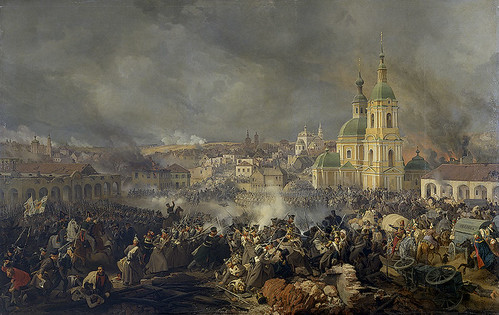Vietnam War: The Battle of Dak To begins.
Tag Archives: 3 November
3 November 1936
Franklin D. Roosevelt is elected President of the United States.
3 November 1936
Franklin D. Roosevelt is re-elected President of the United States.
3 November 1812
Napoleon’s armies are defeated at the Battle of Vyazma.
3 November 1982
The Salang Tunnel fire in Afghanistan kills up to 2,000 people.
[rdp-wiki-embed url=’https://en.wikipedia.org/wiki/Salang_Tunnel_fire’]
3 November 1911
Chevrolet starts competing with the Ford Model T.
William Crapo Durant’s greatest failure led to the creation of Chevrolet. A year after he incorporated General Motors, he went after Henry Ford’s third, and most successful, car company. Ford, according to Lawrence R. Gustin’s biography of Durant, was concerned about Selden’s patent suit claiming invention of the automobile, and was amenable to selling to GM if he could retain the rights for motorized farm implements.
GM was to pay Ford $2 million cash, plus $4 million at 5 percent interest over three years. On October 26, 1909, GM’s board “gave Durant authority to purchase Ford if financing could be arranged,” Gustin writes in “Billy Durant, Creator of General Motors.”
Banks were nervous about the nascent, fly-by-night auto industry, and refused Durant a $2 million loan for the downpayment. During a financial panic in 1910, GM’s board kicked Durant out and let bankers take over his company.
Durant began work on his comeback and set up retired Buick race driver Louis Chevrolet with his own Detroit shop in early 1911. Durant returned to Flint, Michigan, where he had seeded GM in the early 1900s, and bought the assets of the failing Flint Wagon Works. He then got former Buick engine builder Arthur C. Mason to set up a new operation, while Durant organized the Little Motor Car Company.
Durant incorporated the Chevrolet Motor Company on November 3, 1911. Louis Chevrolet was not an officer, but he experimented with large luxury cars while Chevrolet Motor Company’s Little brand sold lower-priced cars against Ford. The first “production” Chevrolet was the big, $2500 Classic Six of 1912, but the first Chevys, as we know them, were the 1914 Royal Mail roadster and Baby Grand touring car. Louis Chevrolet left his namesake company to return to racing.
The 1916 Chevrolet Four-Ninety was Durant’s direct shot at the Ford Model T. By now, Chevy was thriving with factories in places like Flint and New York City. Its success gave Durant the footing to buy up GM stock, with help from the DuPont family and a New York bank president, Louis J. Kaufman. Durant staged a coup d’etat, and on September 16, 1915, GM’s seventh anniversary, took control of GM again.
On December 23, 1915, Chevrolet stockholders increased capitalization from $20 million to $80 million, Gustin writes, and used the $60 million to buy up GM stock. Chevrolet bought GM. It wasn’t the other way around.
3 November 1812
Napoleon’s army is defeated at the Battle of Vyazma.
The Battle of Vyazma, occurred at the beginning of Napoleon’s retreat from Moscow. In this encounter, the rear guard of the Grande Armée was defeated by the Russians commanded by General Mikhail Andreyevich Miloradovich. Although the French repelled Miloradovich’s attempt to encircle and destroy the corps of Louis Nicolas Davout, they withdrew in a partial state of disorder after suffering heavy casualties from continued Russian attacks.
The French reversal at Vyazma was not decisive, but it was noteworthy because of its disruptive impact on the Grande Armée’s retreat.
Miloradovich’s cavalry attacked the disorganized French column holding the length of road which separated the I Corps from the IV and V Corps. Miloradovich also ordered his artillery, positioned on nearby heights, to begin a cannonade. The attack was a complete success, as it captured the French IV Corps baggage train and sent the French troops fleeing in disarray. Miloradovich then placed infantrymen and horse batteries astraddle the road, thereby severing Davout’s connection with the rest of the French army.
Simultaneous to Miloradovich’s attack to the west of Davout, Platov’s Cossacks attacked Davout from the east, supported by Paskevich’s troops. Davout’s infantrymen formed squares to meet the attack from Platov and Paskevich, and his artillerymen set up their pieces to return Miloradovich’s fire. The 14,000 exhausted, hunger-weakened soldiers of Davout’s Corps were now at risk of being overwhelmed and destroyed by the Russians.
3 November 1954
The first Godzilla movie is released.
Godzilla is a 1954 Japanese science fiction kaiju film featuring Godzilla, produced and distributed by Toho. It is the first film in the Godzilla franchise and the first film in the Showa series. The film is directed by Ishir? Honda, with a screenplay by Honda, Takeo Murata, and Shigeru Kayama and stars Akira Takarada, Momoko K?chi, Akihiko Hirata, Takashi Shimura, with Haruo Nakajima and Katsumi Tezuka as the performers for Godzilla. Nakajima would go on to portray the character until his retirement in 1972.
In 1956, TransWorld Releasing Corporation and Embassy Pictures released Godzilla, King of the Monsters!, a heavily re-edited “Americanized” version of the original film with additional footage featuring Raymond Burr. In 2004 Rialto Pictures gave the 1954 film a limited theatrical release in the United States to coincide with the franchise’s 50th anniversary.
3 November 1982
A fire in the Salang Tunnel in Afghanistan kills almost 2000 people.
3 November 1812
Napoleon’s armies gets beaten at the Battle of Vyazma



